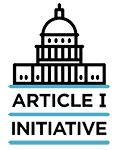This month we are sharing a selection of paired pieces from The Federalist Society’s Liberty Month in July 2015. We hope you enjoy reading them. Click here to visit the paired piece for this entry.
* * *
Separation of powers as a tool for limiting discretionary official power is the foundation stone of our Constitution and the rule of law. No institutional device does more to protect liberty. James Madison called separation of powers “the first principle of a free government” and helped craft a Constitution that divides government power between national and state governments and between different branches of government. In Federalist 51, Madison explained the related concept of checks and balances, saying that “the great security against a gradual concentration” of government power (once separated) “consists in giving those who administer each department, the necessary constitutional means and personal motives, to resist encroachments of the others.”
Not all encroachments, however, have been resisted. A decision in the recently concluded U.S. Supreme Court term (2015) highlights one type of encroachment that has grown out of control. Department of Transportation v. Association of American Railroads asked whether granting Amtrak power to help frame regulations that apply to private railroad enterprises violates the Constitution. The primary complaint was that this grant of power breaches the “non-delegation doctrine.” When the Supreme Court passed that issue back to the lower court, Justices Alito and Thomas thoughtfully described considerations that should guide further review.
The essence of the non-delegation doctrine is that Congress cannot give its legislative power to others. The “vesting clauses” of the Constitution assign different powers to each of the three branches, stating, for example, that “All legislative powers herein granted shall be vested in a Congress of the United States” before going on to state how the Congress will be composed, what powers it will have, and what processes it must observe in passing laws. The Constitution similarly vests executive power in the President’s hands and judicial power in the courts created under Article III. The divisions of power among the branches and the processes established to govern each are essential protections against tyranny; they are the mechanisms that check expansion of discretionary official power.
The Supreme Court has been fairly vigilant in preventing exercise of judicial power by officials not appointed and tenured in accord with Article III’s commands or assignments of executive power that do not observe constitutional requirements respecting appointment and control of executive officers. Its record with respect to congressional efforts to outplace legislative authority, however, has been far weaker.
Basic policy choices on rules that regulate the behavior of others have to be made by Congress: it can’t empower any other official or body to make those rules—essentially to enact laws—bypassing democratic election of the officials, bicameralism (different constituencies, criteria, and terms of office for House and Senate), presentment to and approval by the President, and other procedural protections built into the Constitution’s design. Language from Supreme Court opinions in the late 1800s and 1920s, however, laid the groundwork for judicial acceptance of laws authorizing broad policy-making by executive officials (outside fields of independent, constitutionally-assigned executive power).
The Court found this permissible so long as Congress sets out an “intelligible principle” that binds executive officials. Although the Court struck down two laws in the 1930s for failing that test, it has approved numerous laws that give no meaningful direction. The FCC, for example, is authorized to hand out licenses to spectrum users “as the public convenience, interest, or necessity requires”—in other words, as it sees fit. Many other laws are so complex, self-contradictory, or opaque as to leave wide fields of discretionary power in administrators’ hands. The 848-page Dodd-Frank Wall Street Reform Act and the 900-plus-page Affordable Care Act (Obamacare) are just two other examples.
Congress’s failure to make the hard choices among competing policies and to give real direction to those asked to administer its burgeoning laws effectively transfers law-making power to unelected and largely unchecked officials. It also encourages ever more lawmaking by Congress (now freed from the hardest work). Congressionally enacted laws today cover nearly 30,000 pages; administrative rules occupy more than 180,000 pages! Citizens are held accountable—even criminally liable—for failing to adhere to directions spread across this ever-expanding maze.
Unchecked discretionary official power inevitably erodes liberty. It’s time to reinvigorate the non-delegation doctrine and resuscitate the constitutional system of separate and limited government powers. That will be hard work for judges, and another source of concern for those fearing a less constrained judiciary. Still, it is a risk worth taking to revive limits on law-creation central to our founding charter—while we can.

 Hon. Ronald A. Cass
Hon. Ronald A. Cass 